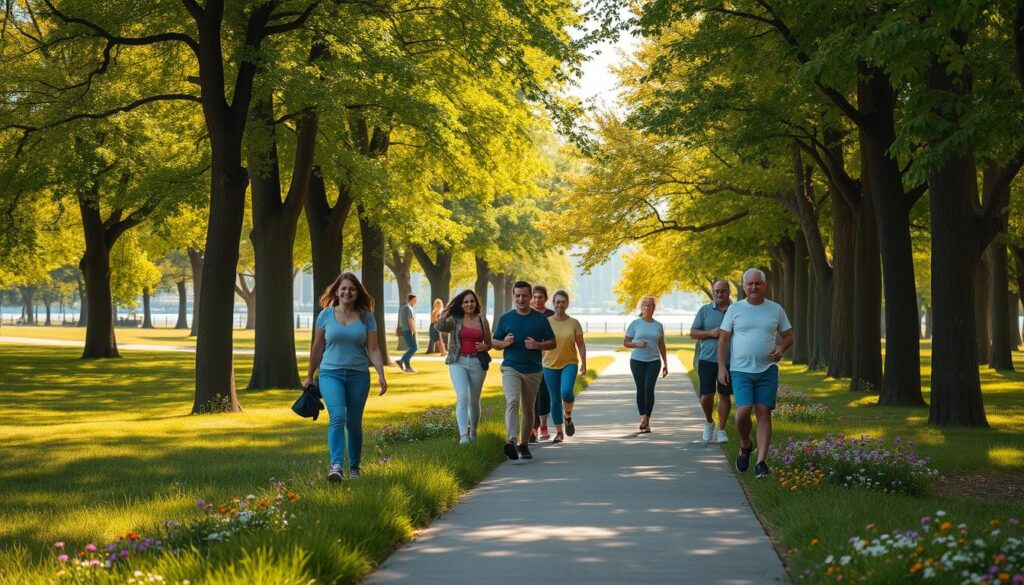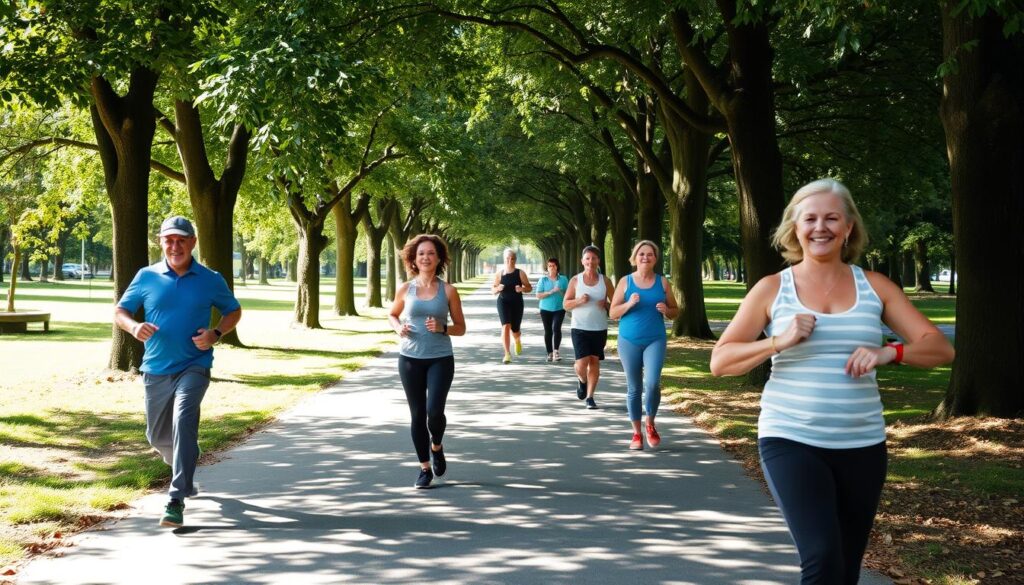Many people wonder if walking 30 minutes a day can build muscle. Walking is great for health including strength. But it might not build big muscles.
It can however increase lean muscle and burn fat which is key for bodybuilding.
Walking also boosts health, energy, and mental well-being. It’s a great part of a fitness plan that includes strength training. This combo can help build muscle.
Key Takeaways
- Walking 30 minutes a day can improve overall health and increase lean muscle mass
- Regular walking can help burn excess body fat, which is essential for bodybuilding and building muscle
- Walking alone may not be enough to build big, bulky muscles, but it can be an excellent addition to a fitness routine that includes strength training
- Incorporating walking into a daily routine can improve energy levels and enhance mental well-being
- A combination of walking and strength training can help build muscle and improve overall fitness
- It’s essential to incorporate strength training into a fitness routine to build muscle, as walking alone may not be enough
- Walking can be an excellent way to improve cardiovascular health and reduce the risk of chronic diseases
Understanding the Relationship Between Walking and Muscle Development
Walking is a low-impact exercise that’s good for your health and fitness. It works out many muscle groups like your legs glutes, and core. Regular walking can make these muscles stronger and boost your physical activity.
Studies show walking has many health benefits. For instance, it can lower your risk of stroke hip fractures, and heart disease. A study found that women who walked 30 minutes a day cut their stroke risk by 20%. This risk drops to 40% if they walk faster.
How Walking Engages Different Muscle Groups
Walking works out many muscle groups like your quadriceps hamstrings, and glutes. It also strengthens your core which helps with posture and balance. Plus, walking your arms can work your arm muscles too.
The Role of Low Intensity Exercise in Fitness
Low-intensity exercise, like walking is great for fitness and health. It improves heart health boosts mobility, and lowers disease risk. It’s also perfect for beginners or those with mobility issues.
Walking vs. Other Forms of Exercise
Walking is easier on your joints than high-impact activities like running. It’s also a low-cost accessible option compared to cycling or swimming.
| Health Benefit | Walking Duration | Risk Reduction |
|---|---|---|
| Stroke | 30 minutes/day | 20-40% |
| Hip Fractures | 30 minutes/day | 40% |
| Cardiovascular Disease | 30 minutes/day | 10-20% |
The Science Behind Does Walking 30 Minutes a Day Build Muscle?
Walking is a low-impact exercise that helps the heart and improves blood flow. It’s not as good as weightlifting for building muscle. But, it does work some muscles in your legs and back.
Walking can also make your veins stronger and blood flow better. This can help prevent varicose veins. It also lowers the risk of getting disabled or having arthritis pain as you get older. Studies show that walking for 10 minutes a day can make a big difference.
Walking is great for your health. It can lower the risk of chronic diseases make you feel happier, and burn more calories. Here are some benefits of walking:
- Reduces rates of chronic disease
- Improves mood
- Increases calorie burn
- Strengthens the venous system and improves blood flow
https://www.youtube.com/watch?v=3Ka7B3hCg08
While walking might not build muscle as well as weightlifting, it’s still good for you. It adds many benefits to your health and can help with muscle building.
| Benefits of Walking | Description |
|---|---|
| Reduces chronic disease risk | Walking for at least 30 minutes a day can significantly reduce rates of chronic disease |
| Improves mood | Research indicates that just 10 minutes of walking can lead to a notable increase in mood |
| Increases calorie burn | Walking can help increase calorie burn contributing to weight management and overall fitness |
Caloric Expenditure and Metabolic Impact of Daily Walking
Walking every day can greatly affect how many calories you burn and your metabolism. This can help you lose weight and stay healthy. Adding walking to your daily routine boosts your chances of reaching your fitness goals. Whether you want to lose fat or keep a healthy weight, walking can help.
The Department of Health and Human Services suggests 150 minutes of moderate exercise weekly for adults. Walking for 30 minutes a day, five days a week meets this goal. This can burn about 150 calories each time, helping you lose weight.
Walking also improves your metabolism and helps keep muscle mass. This is great when you’re eating fewer calories. To get the most from walking mix it with strength training and other exercises. Remember to drink water and sleep well to support your health and fitness goals, whether at the gym or home.
Some key benefits of regular walking include:
- Increased caloric expenditure
- Improved metabolic efficiency
- Preserved muscle mass
- Enhanced overall health and fitness
Benefits of Walking Beyond Muscle Building
Walking is a great exercise that does more than build muscles. It boosts heart health raises energy, and lifts your mood. For example a study in The Journal of Human Hypertension showed walking can lower blood pressure.
Walking also helps your mind. A study in The Journal of Mental Health and Physical Activity found it can ease depression. This makes walking a top choice for better mental health.
Some key benefits of walking include:
- Improved cardiovascular health
- Increased energy levels
- Enhanced mental well-being
- Weight management
- Improved bone density
Walking is perfect for those new to fitness or with mobility issues. It’s a gentle way to get fit. Adding walking to your day can greatly improve your health.

Read more: Functional Fitness Burn Fat Build Strength
Whether you enjoy hiking or just strolling, walking is a fantastic way to stay active. So why not put
on your shoes and start today?
Optimizing Your Walking Routine for Maximum Results
To get the most out of your walking routine, focus on proper form and technique. Keep good posture, engage your core, and land midfoot or forefoot when stepping. This reduces injury risk and boosts your fitness.
Adding intensity and pace changes makes walking more engaging and challenging. Try short bursts of brisk walking followed by slower periods. Also walk uphill or on uneven surfaces to add variety and challenge.
- Start with short periods of walking and gradually increase your duration and intensity over time
- Incorporate strength training exercises, such as squats and lunges, to improve muscle engagement and weight loss
- Use an activity tracker or pedometer to monitor your progress and stay motivated
- Wear proper footwear and attire to reduce your risk of injury
By following these tips and adding walking to your fitness routine, you can see big health benefits. You’ll lose weight and improve your fitness and exercise habits.
Combining Walking With Strength Training
Walking and strength training together can help build muscle and boost fitness. A good workout plan should mix cardio and strength exercises. Walking is excellent for the lower body, like glutes, hamstrings, and quads.
To mix walking with strength training, balance is key. Include walking and exercises like squats lunges, and leg press. Here’s a weekly plan:
- Monday: 30-minute walk + strength training lower body
- Wednesday: 30-minute walk + strength training upper body
- Friday: 30-minute walk + strength training core
Strength training with walking boosts fitness and muscle. Start slow and increase workout intensity and time. Listen to your body and rest when needed.

With a balanced workout plan, you can reach your fitness goals and enhance health. Whether you’re new or experienced walking and strength training are great for muscle and fitness.
| Day | Workout | Duration |
|---|---|---|
| Monday | Walking + strength training lower body | 30 minutes |
| Wednesday | Walking + strength training upper body | 30 minutes |
| Friday | Walking + strength training core | 30 minutes |
Nutrition Considerations for Walking and Muscle Growth
Proper nutrition is key for muscle growth and staying fit. A balanced diet with protein, complex carbs, and healthy fats is crucial. It helps with muscle growth and keeps you healthy. Adding regular walking to a good diet can help you reach your fitness goals.
Improving your walking routine with the right nutrition is important. Here are some tips:
- Hydration: Drink lots of water before, during, and after walking.
- Protein intake: Eat foods high in protein to help with muscle growth.
- Complex carbohydrates: Choose whole grains, fruits, and veggies for energy.
- Healthy fats: Nuts, seeds, and avocados are good for overall fitness.
Here’s a meal plan to help with muscle growth and fitness:
| Meal | Food | Portion |
|---|---|---|
| Breakfast | Oatmeal with banana and almond milk | 1 cup |
| Lunch | Grilled chicken with quinoa and vegetables | 4 oz |
| Dinner | Salmon with sweet potato and green beans | 6 oz |
By eating right and walking regularly you can boost muscle growth and meet your fitness goals.
Common Mistakes to Avoid in Your Walking Routine
Many people don’t focus on the right form and technique when walking. This can make workouts less effective and even cause injuries. To get the most from your walking and reach your fitness goals it’s key to avoid common errors. Walking regularly can help build muscle and improve fitness, but it must be done right.
Some common mistakes include improper form and posture, which can strain your joints and muscles. This can cause injuries and make your workouts less effective. Not increasing the challenge of your walks can also slow your progress. And forgetting to rest can lead to burnout and lower motivation.

Read more: Yoga vs Gym Which Workout is Better for You?
To avoid these mistakes, focus on the right form and technique. Gradually make your walks more challenging. And don’t forget to rest and recover. This way, you can make walking a key part of your fitness plan, helping you build muscle and stay fit.
By avoiding these mistakes and adding walking to your routine, you can see many benefits. These include better heart health, stronger muscles, and overall fitness. Walking is a great way to improve your health and fitness, whether you want to build muscle or just feel better.
Special Considerations for Different Fitness Levels
When it comes to walking and exercise, everyone has their own needs. Beginners should start with short walks of 5 to 10 minutes. Then, they can increase the time to at least 30 minutes to get the most benefits.
Regular walking can also help lower blood pressure and cholesterol. This improves heart health and helps build muscle. It’s important to add strength exercises at least twice a week to boost fitness and muscle building.
For those who are more advanced, a power walk can make the workout more intense. This adds extra fitness benefits.
Some key benefits of walking for different fitness levels include:
- Lowering blood pressure and cholesterol levels
- Improving HDL good cholesterol levels while lowering LDL bad cholesterol
- Managing diabetes by lowering blood sugar levels
- Improving overall fitness and muscle building
Walking is a great way to improve health and fitness. It’s easy to adjust to fit your needs and preferences.
Conclusion Making Walking Work for Your Fitness Goals
Incorporating a daily walking routine into your fitness plan can be very effective. It helps you build muscle, improve heart health or stay active. Walking for 30 minutes a day can make a big difference.
Regular walking not only boosts your fitness but also offers many other benefits. It can improve your mood, reduce stress, and help control blood sugar. It also lowers the risk of chronic diseases. The secret is to make walking a regular part of your routine and challenge yourself by changing the route or speed.
Walking is just one part of the journey to better health and wellness. Combine it with a healthy diet and other exercises to reach your fitness goals. So, put on your shoes, go outside, and start walking towards a healthier, more energetic life.





